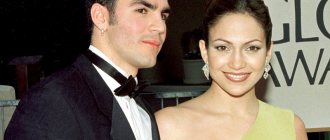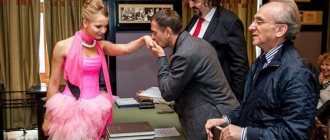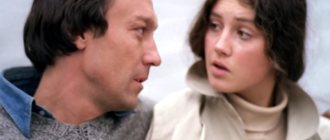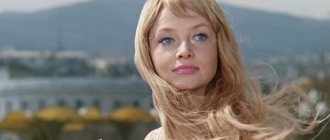Acting art
(architectural
acting)
is a professional creative activity in the field of performing arts, consisting in the creation of stage images (roles), a type of performing arts[1].
When performing a certain role in a theatrical performance, the actor, as it were, likens himself to the person on whose behalf he is acting in the play. By influencing the viewer during the performance, a special playing space and community of actors and spectators are created[1].
The principle of acting[ | ]
The general principle of acting is transformation. Transformation can be external and internal, the method of comprehending it differs depending on the technique used by the actor, school (for example, Stanislavsky or Mikhail Chekhov), factors of external interference in the construction of the role (the work of partners, director, make-up artist, etc.).
The actor's working tools also differ between external and internal.
- External (technological) - makeup, costume, in some types of theater - mask.
- Internal (psycho-physical) - physical: body, plasticity and motor skills, voice (including diction), ear for music, sense of rhythm; mental: emotionality, observation, memory, imagination, reaction speed, ability to improvise.
Actress from the film “Voroshilov Shooter”
Many viewers remember the sweet and shy girl Katya from the film “Voroshilovsky Shooter”.
The role was played by Anna Sinyakina, an actress who is called “Turgenev’s girl of Russian cinema.” Then and now
Anna Sinyakina was born on June 26, 1981 in Moscow into an acting family. Father - Yuri Sinyakin, a graduate of GITIS, studied with Pokrovsky. Mother sang in the choir of the Musical Theater named after. Stanislavsky and Nemirovich-Danchenko.
From an early age, Anna plunged into the theatrical atmosphere; her parents often took her with them to classes and even to exams. She recalled:
I remember how at one of them they began to correct my dad. I was so worried, sitting in my chair, I thought out a phrase for a long time, and as a result I stood up and said: “if you scold my dad, I will eat your shoes.”
They lived in a three-room small apartment for three families. She was raised with two cousins. At school she liked mathematics and literature. She attended various clubs and sections - at different times she was fascinated by dancing, knitting, weaving, karate, and swimming.
She attended a music school where she took a guitar class, but did not graduate because enrollment at Gnesinka was announced.
There I first realized that the “teacher and student” formula no longer works. That now there is only a common cause. This was my first meeting with the profession, -
Anna recalled.
In 2000 she graduated from the Gnessin State Music College, department of musical theater actor, workshop of G.E. Gurvich. Graduation performances in Gnesinka: “A Streetcar Named Desire”, T. Williams - Stella Dubois; musical Corusline - Kristin Urich; “Theatre Director”, V.A. Mozart - Madame Hertz.
In 2004 she graduated from the acting department of RATI-GITIS, workshop of Valery Garkalin. Graduation performances at GITIS: “Suicide”, N. Erdman - Cleopatra Maksimovna; “Forty-one” B. Lavrenev - Maryutka.
Then she was accepted into the theater “School of Dramatic Art” (Dmitry Krymov’s Laboratory), among her works: “Three Sisters” based on the tragedy “King Lear” by W. Shakespeare - Goneril; "Sir Vantes. Donquix Hot" based on the novel "Don Quixote" by Cervantes; “Tendering” is a play by Dmitry Krymov based on the dramatic works of A.P. Chekhov; "Daemon. View from above" based on the poem by Mikhail Lermontov; “Cow” based on the story by A. Platonov - Vasya Rubtsov; “Optimus Mundus” - Desdemona, Olivia, Tatiana; "Opus No. 7"; "The Death of a Giraffe"
She also played at the Moscow Art Theater. A.P. Chekhov: “The Threepenny Opera” - Lucy.
She began acting in films in 1998, making her debut in the film “Full Moon Day” by Karen Shakhnazarov.
The actress became widely famous in 1999, after the release of Stanislav Govorukhin’s legendary film “The Voroshilov Shooter,” in which she played the role of Katya’s girlfriend, Afonin’s granddaughter.
Her heroine is raped; the police, where the father of one of the rapists works, does nothing to punish the criminals. And then her grandfather, a war veteran, decides to carry out his fair trial himself. He buys a rifle with a telescopic sight, rents an apartment opposite the scum's house and begins to punish them.
Govorukhin immediately invited Mikhail Ulyanov to play the role of grandfather. After the film, Anna began to be called his on-screen granddaughter.
Anna recalled about working with Mikhail Ulyanov in the film “Voroshilovsky Shooter”:
I’m a little sad to remember the film “Voroshilov’s Shooter”, because Ulyanov is no longer with us. We met Michal Sanych, as everyone called him, at the audition. They were very long, director Stanislav Govorukhin still could not make his choice. It was then that he called Ulyanov for help and left the last word with him. I remember when I came in, Ulyanov was sitting in an armchair. So good that I immediately wanted to come up to him and sit next to him. We started working. For testing, they took the scene when the granddaughter, after being raped, comes home and is greeted by her grandfather. I was asked to cry at auditions. We did several takes. The first time I cried, but the second and third time I couldn’t. Everything is a stupor, the director swears: “You can’t do anything!” And suddenly Ulyanov says: “You know, I also never cry myself.”
At first I was scared because everyone was attacking me, but after Michal Sanych’s confession, the tense situation eased. “If I cry in a film, then I will have to pour ammonia every time,” Ulyanov said. And somehow it became awkward for everyone to accuse me, an aspiring artist, of not being able to cry if Ulyanov himself... And later, when Michal Sanych was on the set, I was much calmer, I felt protected. There was someone to look at and ask: “So? Am I doing the right thing? Sometimes it really felt like he was my grandfather.
Surprisingly, he did not allow himself to teach! This never happened. But always, if he saw that some point was not working out, he suggested. We couldn’t afford to do many takes; the movie was shot on film, which was terribly expensive - there were no digital cameras then. Maximum of three takes. For example, at first I was very worried and was tense all the time. But it’s wrong to keep yourself in this state all the time, because the filming process is long, it takes a long time to set the lights, and prepare for filming. They are usually removed after a few hours. When the strength is no longer enough. Seeing that I couldn’t relieve this tension and was constantly stressing myself out, Ulyanov said: “Just wait, there’s still a long time before shooting. Don’t bother now...” He very subtly, carefully watched me, saw it all and unobtrusively suggested.
At first I was even afraid of him, I thought: “Oh, such an artist! And I will come... How will it be? But he is so warm and kind that we quickly found a common language. I remember how happy I was when I went out for breakfast in the morning and saw him - we lived in the same hotel. I showed up at the restaurant, and he sat at the table, we ate together. On the first day of filming, I took myself something to drink and some salad... Michal Sanych watched me carefully, appraisingly. And then, when we appeared on the set, he said: “She ate little today, she will be angry, which means she will work well.” And with these words he immediately relieved the tension on the site. For me, this was the first big picture, and the first time I encountered such a master.
About working with Stanislav Govorukhin:
I didn't feel any pressure. They probably didn’t expect anything special from me, but they always listened carefully to all my proposals, and after listening, they almost always found a reason to joke. It was great working on this picture. Michal Sanych and I were gathering at Stanislav Sergeevich’s hotel room. He had a huge apartment with a kitchen, and in the evenings we would come to talk about the next scene, cook dumplings and eat them.
They forced me to cook dumplings. I'm not a special cook. By the way, we inserted the scene with dumplings into the film. I cook them for my grandfather. The film “Voroshilovsky Shooter” was filmed in Kaluga. We lived there for two months at the Priokskaya Hotel. On weekends we went out to sunbathe, swim and barbecue. The best memories remain from filming.
About Marat Basharov and Vladislav Galkin:
They brought a slightly different atmosphere. Boyish, some kind of fast, after filming in the evening they would have gatherings in the hotel garden, sometimes even with fireworks. I almost never stayed with them after filming because I was learning to play the guitar.
The hardest part of filming:
We thought for a long time about how to make the ending of the film because there were several options. My heroine sings “Lonely Accordion” at the end of the film. But at first they thought that maybe it would be better to take a military song. They also decided what Ulyanov should do: listen, sing along and cry, or listen and, as it were, be reborn. There was an option when they wanted to come up with a small monologue. As a result, they settled on what seemed the best: the granddaughter, returning to life after the tragedy, plays the guitar and sings, and he quietly listens outside the door and cries.
Despite the fact that I studied guitar a little at a music school, playing and singing at the same time was very difficult for me. Knowing that I would have to do this on camera, I learned to sing and play every day for a month. But all the same, when I came to the shoot, my teeth were chattering, my fingers were shaking, and I was terribly worried.
How the rape scenes were filmed:
Everyone was worried then. We thought about how to convey it all delicately, without making it look vulgar or disgusting. We searched for a long time. One of my heroine’s rapists, actor Ilya Drevnov, was the most nervous about this scene. And our cameraman Gennady Engstrem, a great joker, intimidated him: “Here we will put a chair and film you naked from behind.” And Ilya said: “No. This is impossible". The solution to the scene came naturally. At the time of filming, I was underage and categorically refused to undress. The naked body parts in the film are not mine.
I initially asked for a stunt double. And it’s not even that I wasn’t allowed to be naked. Having received my parents' consent, I could undress, but I was very embarrassed. We thought for a long time about how to replace me with an understudy. I was lying on the bed and suddenly grabbed the blanket and threw it over me so that I could not be seen. A solution has been found. The other girl was hidden under a blanket.
Also in 1999, she played the main role (Olga) in Vasily Panin’s social drama “We Have to Live Again” based on the stories of Andrei Platonov.
For the role of Olga, she received the Prize of the VIII International Children's Film Festival "Artek" as the best actress.
Later she played the main roles in the films “The Race for Happiness” (Nastya, Ilyich’s daughter, who is in love with Bogdan) and “Soldier’s Tales of Sasha Cherny” (Tanya).
In 2013, the drama “Late Repentance” with Anna Sinyakina in the title role (Kira Arsenyeva) was released.
The story of the film begins in Alushta in 1989. Classmates Kira and Sergei love each other and make plans for the future. Until Kira's mother, a cruel and domineering woman, finds out that her 15-year-old daughter is pregnant. The mother's lover, a gynecologist, performs an abortion on the girl. Sergei finds out about this too late. This tragedy breaks the feelings of young people.
As a rule, the actress is invited to play the role of sad ladies, so the media nicknamed her Turgenev’s young lady. She played small roles in the films “Poor People” (Inessa) and “Anna Karenina” (Annushka).
In total, Anna has two dozen films to her credit. She last starred in the TV series “Tell the Truth.” Currently, she can hardly be seen anywhere, although the actress herself spoke about existing new projects. Probably because she is primarily a theater artist.
Sinyakina belongs to the category of people who do not like to talk about their personal lives. She keeps everything away from prying eyes. Anna doesn't even have a page on social networks. It is known that she has a husband. Nobody knows about the presence of children.
Sources: 24smi.org, stuki-druki.com, fakty.ua, express-novosti.ru
Updated 20/08/19 18:02
:
Literature[ | ]
- Georgy Tovstonogov rehearses and teaches
- Literary recording by S. M. Losev. St. Petersburg: Baltic Seasons, 2007. - Zakhava B. E. The skill of an actor and director
- M., 1969. - Korogodsky Z. Ya. First year
- Leningrad, 1991. - Stanislavsky K. S. An actor’s work on himself.
An actor's work on a role. Collection Op. in 8 vols. Tt. 2, 3, 4. M., 1954-1957. - Creative heritage of Sun.
E. Meyerhold - M., 1978.
Style and influence
The narrative is non-linear and is complicated by flashbacks and clips from films in which Fujiwara played. Tachibana and his cameraman also appear in the films, with Genya always playing the role of protector of Chiyoko's heroines. Once he saved her in reality, back when he was an inexperienced assistant at a film studio. The cameraman does not play any role; in addition, his camera remains with him.
The film is built on a historical reflection of changing times, some scenes are reminiscent of ukiyo-e, others are reminiscent of Akira Kurosawa films, especially Throne of Blood, while there are no references to other films in the narrative. Instead, the director tried to create an overview of the history of Japanese filmmaking. Satoshi claims that before Millennium Actress he was not familiar with historical cinema and learned a lot while preparing the anime. In particular, he learned a lot about the history of kimono [ source not specified 2658 days
].
Chiyoko herself is partially based on famous actresses of the 1940s - 1960s Setsuko Hara and Hideko Takamine, the latter was even specially interviewed by Satoshi; however, according to him, no woman is completely the prototype of Chiyoko.
Christine Asmus
The most beautiful Russian actresses often come to cinema from other, no less creative industries (for example, from sports). This happened with Christina Asmus (04/14/1988). Her real name is Myasnikova, and she got the spectacular pseudonym from her grandfather with German roots. The girl grew up in a poor, large family that had to live in a cramped apartment. Since childhood, Christina has been involved in artistic gymnastics and even received the degree of candidate for master of sports. But over time, the dream of becoming an actress took over. After school, Kristina managed to enroll in the Moscow Art Theater, taking a course with Konstantin Raikin. The girl simply got lost among her bright fellow students and was expelled. After that, she faced 2 years of testing. Asmus tried to work in the theater, she had to sell tickets. There was a bold attempt to open your own Event agency. Later she entered the Theater School. Shchepkina, which she successfully graduated in 2012. Since then, the actress has been working at the theater. Ermolova. Kristina Asmus gained popularity while filming the series “Interns.” Then there were roles in the films “Christmas Trees”, “Cinderella”, “Understudy”, “Easy to Know”, “Champions” and others. It is also worth noting her participation in the shows “Ice Age 5”, “Without Insurance”. For a long time, the main role in the personal life of Christina Asmus was played by Viktor Stepanyan. But, like many other most beautiful Russian actresses, she chose to break off the relationship in order to build a career. Later, fate brought her together with Garik Kharlamov. Despite the problems associated with the showman's previous marriage, the young people managed to build a happy family, and in 2014 they had a daughter.











